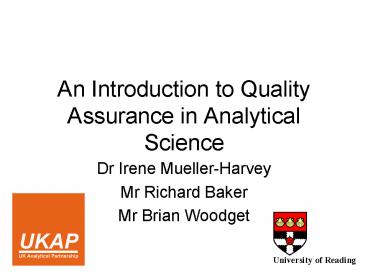An Introduction to Quality Assurance in Analytical Science - PowerPoint PPT Presentation
1 / 13
Title:
An Introduction to Quality Assurance in Analytical Science
Description:
automatically (no more than a 2 second delay), by mouse click or by use ... Coefficient of. variation (CV) or relative standard. deviation (RSD) ... – PowerPoint PPT presentation
Number of Views:105
Avg rating:3.0/5.0
Title: An Introduction to Quality Assurance in Analytical Science
1
An Introduction to Quality Assurance in
Analytical Science
- Dr Irene Mueller-Harvey
- Mr Richard Baker
- Mr Brian Woodget
2
Part 4 - Regulation and Accreditation
- Contents
- Accreditation (slide 3,4)
- ISO 17025 (slides 5-7)
- Inter-laboratory proficiency testing (slides
8-11) - Evaluating analytical quality (slides 12-13)
The presentation contains some animation which
will be activated automatically (no more than a
2 second delay), by mouse click or by use of the
page down key on your keyboard.
3
Accreditation
Accreditation Certificate
- Accreditation is defined as
- Formal recognition that
- a testing laboratory is competent to carry out
specific tests
4
Accreditation which standard?
A number of universally recognised Accreditation
systems
ISO 9000 applicable mostly to manufacturing
services - emphasis on records and customer
service
Good laboratory (GLP) and good manufacturing
practice (GMP) recognised for pharmaceutical and
clinical measurements - emphasis on records,
procedures, reproducibility
ISO 17025 used by analytical laboratories for
work outside the health sector - emphasis on
valid data, traceability, comparisons and data
recognition in a court of law
5
ISO 17025 Accreditation
Main features of accreditation
- Guarantee to customers
- work to agreed standards
- Laboratory
- independent stringent assessment
- Agreed specified methods used
- All measurements traceable to
- national international standards
6
ISO 17025 Accreditation
How do you become accredited?
1 Install a quality system in the laboratory that
complies with the ISO 17025
requirements 2 Decide on the schedule of tests
that are to be accredited 3 Apply to
the United Kingdom Accreditation
Service (UKAS) 4 Have a Pre-assessment visit
from the UKAS assessors 5 Have a formal
Assessment visit from UKAS 6 Clear any
non-compliances they find 7 Become Accredited
for the chosen schedule of tests
7
ISO 17025 Accreditation
How do you remain accredited?
- pay an annual subscription
- perform satisfactorily in inter-laboratory
proficiency tests - undergo and pass regular horizontal and
vertical audits
Mostly concerned with the overall
quality management system
Will trace sample paths from initial acceptance
to final report
8
Inter-laboratory Proficiency Tests
Many laboratory tests are used for international
or national standard and regulations, for example
- food labelling,
- water quality,
- animal feeds,
- pesticide residues.
The authorised laboratories must show that their
results are comparable with others doing the same
tests.
9
Proficiency Schemes (1)
Participation in proficiency testing schemes
offer the following benefits
- Show labs how well they compare with others
- Help them to reduce the overall variability in
testing
- Give the regulatory authorities and consumers
confidence that their quality criteria are
meaningful
10
Proficiency testing (2)
Organisers of such schemes must ensure that
- all participating labs receive identical samples
- a true value is assigned for the result of a
test (for example it may be the mean of all
participants results) - participants do not know the true result before
they do the test.
11
Proficiency testing (3)
From the results submitted by the participating
laboratories, the organisers can
- rank the laboratorys performance by calculating
its z-score - identify the laboratories that can produce
acceptable results for the test - show divergent laboratories how they need to
improve their performance of the test.
12
Calculation of z scores
A laboratorys z-score is calculated from
(x - X)/SD x the lab result X the
true or accepted result SD target
value for the standard deviation
The graph above shows the z scores obtained by
120 laboratories who participated in a particular
proficiency testing scheme
The best performing laboratories have z values
close to zero. The acceptable range is 2 to -2
13
Variation of CV with analyte level
We can expect a CV to be approx. 5 at a 1g/l
level and approx. 15 at a 0.001g/l level
60
50
40
30
Coefficient of variation (CV) or relative
standard deviation (RSD)
20
- 10
0
-10
-20
-30
-40
-50
-60
10
0.1
1 ppm
1 ppb
10-1
10-3
10-6
10-9
- Concentration

